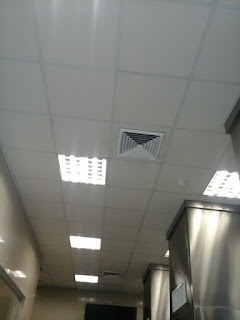The following photos are taken in different locations:
A.) A 2-storey house:
These images apply in the The National Building Code Section 1215 which explains about Lathing, Plastering and Installation of Wallboards.
Both pictures shows walls that are made of cement which follows the fire - resistive requirements. These walls are made from concrete hollow blocks piled together and properly coated with cement. This type of construction follows the fire - resistive norm. The fire - walls are connected to neighboring houses to avoid further spread of fire.
Member's name: Silvano, Meilin E.
B:) A fireplace in a cottage house:
These image apply in the The National Building Code Section 1211 which involves in chimneys and fireplaces. As mentioned in the previous article, it emphasizes the standard location, size, and spacing of these architectural features.
Based on the picture, rubble stones were used in the chimney walls and the minimum thickness and measurement were attained as mentioned on the specific section mentioned. It is well constructed knowing that the structure is mainly made of wood.
Member's name: Lim, Abigail M.
Chimneys, Fireplaces and Barbecues
Fireplaces, barbeques, smoke chambers, and fireplace chimneys shall be of solid masonry or reinforced concrete and shall conform to the minumum requirements specified in this code.
A. Corbelling
No masonry chimney shall be corbeled from a wall more than 150 millimeters nor shall a masonry chimney be corbeled from a wall which is less than 300 millimeters in thickness unless it projects equally on each side of the wall. In the second storey of a two-storey building of Group A occupancy, corbelling of masonry chimneys on the exterior of the ecnclosing walls may equal the wall thickness. In every case the corbelling shall not exceed 25 millimeters in projection for each course of brick
Below is a picture from Exallot Building Products, UK that shows corbelling masonry chimney on the exterior of the enclosing walls, The corbelling is equally projected on each side.
Corbelling
B. Fireplaces and Barbecues
Walls of fireplaces shall not be less than 200 millimeters in thickness. Walls of fireboxes shall not be less than 250 millimeters in thickness: Except, that where a lining of firebrick is used, such walls shall not be less than 200 millimeters in thickness. The firebox shall not be less than 500 millimeters in depth. The maximum thickness of joints in firebrick shall be 10 millimeters.
Fireplace Walls
The above picture from http://thediymommy.com/ed shows firebricks are to line the inner walls of the fireplace. Reinforced concrete is used for the main walls and laid with natural stones as the final finishing touch.
B. Hearth
Every fireplace shall be provided with a brick, concrete, stone, or other approved non-combustible hearth slab at least 300 millimeters wider on each side then the fireplace opening and projecting at least 450 millimiters therefrom. This slab shall not be less than 100 millimeters thick and shall be supported by a non-combustible material or reinforced to carry its own weight and all imposed loads.
The picture above shows hearth made out of concrete lined with bricks. The opening and projecting of the fireplace is about 450-500 millimeters. It is important to note that only non-combustible materials are to be used in hearths and chimneys.
Member's name: Caballes, Wendylle
.
C.) A showroom kitchen:
These images apply in the The National Building Code Section 1211 ,specifically installation of barbecues with ranges and hoods.
This restaurant kitchen shows the location and mechanism of ranges, barbecues and hoods. The stainless steel material has always been the standard and most used metal for most kitchen appliances whether structural or unattached. It shows the anti-corrosion property of such metal and connections of smoke proof construction. With ventilation and smoke detectors provided on hoods, it adjusts the temperature of heat and proper expulsion of smoke. Volatile materials are kept away from these metallic structures.
Member's name: Bacud, Regine Joy V.









Great and really helpful article! I agree with all points you have given to us, i will follow them. It provides more information and expresses a new point of view.
ReplyDeletethey really show every detail of their topic from pictures down to the descriptions, the use of pictures really help out, some readers prefer to see pictures on it cause it would really make them understand and provides more information to how and when to apply the NBCP.
ReplyDelete(http://ppgsix.weebly.com/) Group 6
ReplyDeletethat was a very informative and organized blog. Its nice how the blog made it easier for the readers to understand it since the topics are common here in the Philippines except for the fireplace part. Even people who don't study Interior Design could actually learn from this. Also, it is great how the pictures clearly show what the topic is about. Good Job!
Can a barbecue be built under the roof of a covered patio? Is there a fire danger associated with this? Will the smoke discolor the ceiling of the patio cover?
ReplyDelete